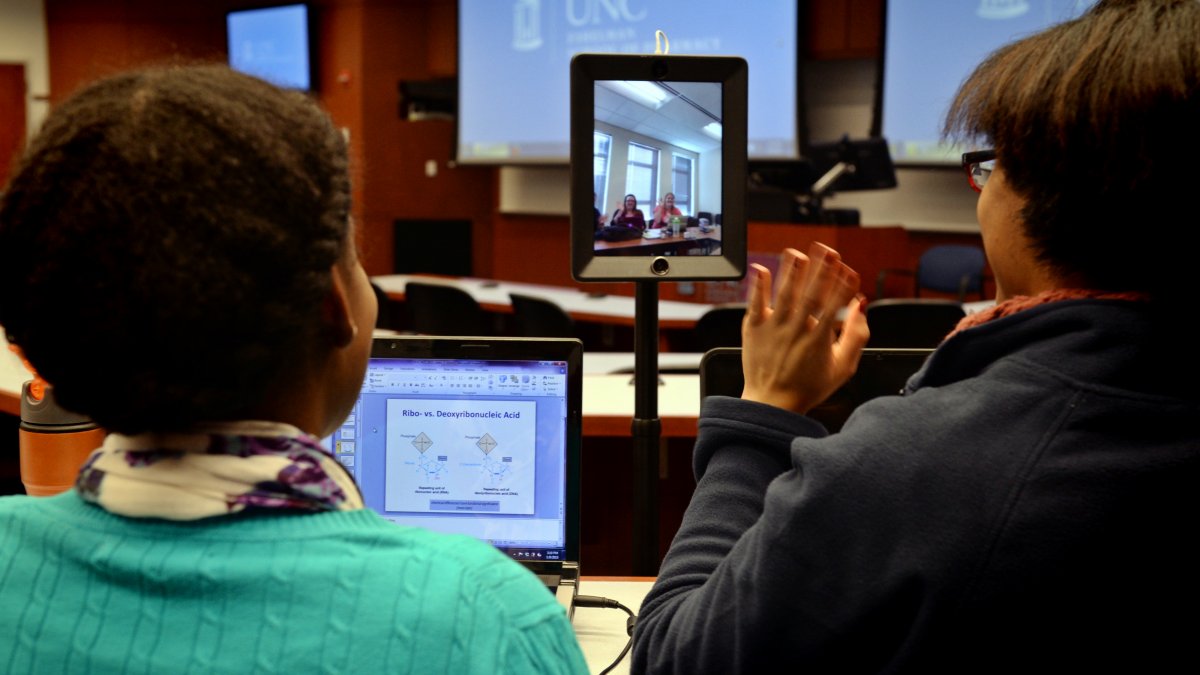Robots to the rescue!
The Eshelman School of Pharmacy owns three Double Robotics robots, two in Chapel Hill and one at the school’s satellite campus in Asheville. Each one is basically an iPad mounted on a remote-controlled base that looks something like a Segway.

Matthew Brown is grateful for the UNC Eshelman School of Pharmacy robots. Otherwise, the third-year pharmacy student wouldn’t have been able to keep up with his classes this semester while receiving treatment for cancer.
Brown’s treatment plan includes four cycles of chemotherapy; each cycle requires five days of infusion, and each infusion lasts five to six hours. While he could stream or watch recordings of his lecture classes, he also was required to participate in a smaller interactive group of 10 to 12 students in a course called “Problems in Pharmacotherapy.” The class would have been, well, a problem – if not for the robot that let him dial in to class with his iPad.
“I use my iPad to control the robot and use ear buds with a microphone to interact with my group. I am able to move the robot during the meeting to, say, look at the white board or a specific person,” Brown said. “Without the robot, I would not have been able to continue in school this semester because group participation is heavily weighted in our ‘problems’ course grade.”
The school owns three Double Robotics robots, two in Chapel Hill and one at the school’s satellite campus in Asheville. Each one is basically an iPad mounted on a remote-controlled base that looks something like a Segway.
On its one wheel, the robot rolls forward, backward, left and right, and can make turns. The user controls the robot’s motion from a distance with a laptop, iPad or even an iPhone using an app and a wireless connection via Bluetooth. The iPad screen on top faces forward from wherever the wheel has placed it and can be raised or lowered on the pole, but it doesn’t turn independently.
The pharmacy school has been a pioneer at Carolina in videoconferencing, beginning in 2005 with classes taught by professors in Chapel Hill to students in other parts of the state.
With giant 12-foot screens in both rooms, the lecturers loom over their remote students and can see their much-smaller faces looking back – not so different from the in-class experience. The school is now wired with 19 videoconferencing classrooms, 13 here (in Beard, Kerr and Marsico halls) and six in Asheville.

Casey Emerson talks with Ben Halligan at UNC-Asheville on the video conference robot as he walks down a hall in the Eshelman School of Pharmacy.
“We have the lecture thing down,” said Casey Emerson, until recently the director of education technology at the pharmacy school. “Where we know we have room for improvement is one-on-one interaction.”
The school began looking for small-group alternatives about five years ago. Existing options included Skype, Face Time and one-on-one videoconferencing. The school used that last technology to create “office hours” – a room the size of a phone booth, equipped with a computer, video camera and a smart podium screen that allows the user to write formulas or draw diagrams.
But none of these options allowed remote users to control their view. They would have to be satisfied with a static view or rely on someone on the other end to move the remote device.
So, inspired by mobile medical robots used at hospitals, the school explored the robot option. They discovered that the Double Robotics robot offered mobility and the ability to interact easily with more than one person at a time for much less than the medical models cost.
With the robot, the user can turn to address people all around a conference table, roll over to a desk to take a student’s question or even scoot behind students to see how many are on Facebook during class.
And since the iPad used as the “face” of the robot is roughly the size of a human face, “You don’t have this lording over you presence,” Emerson said. “You can look someone in the eye.”
As a graduate student, Emerson used the robot when one of his classes conflicted with his job monitoring the computer control room. “I used the robot to connect up to a class,” he said. “I listened to the lecture, then drove over to my small group, worked with my group and went back to the lecture. It worked just fine.”
Other students, like Brown, have used the robot when illness or injury kept them from attending class. One student even dialed in all the way from Budapest, Hungary, where he was attending a wedding.
Faculty members like the robot, too. Greene Shepherd, a Carolina professor based in Asheville, has attended meetings with it, but finds the robot most useful when working with small groups in Chapel Hill – like in the “Problems in Pharmacotherapy” class.
“Using our standard videoconference meeting rooms, everyone in the group appeared tiny, and I had no way to zoom in when someone was talking. This is where the robot has come in handy,” Shepherd said. “The robot allows me to control who and what I look at, and even to move around in the room if needed. From my point of view, it really allows me to be a more effective facilitator when I am working remotely.”
The videoconferencing robot gets attention whenever it’s rolling down the hallway with the remote operator looking out from the iPad screen and talking to passersby. Dean Bob Blouin counted on that “wow” factor when he gave his presentation at a recent UNC Board of Visitors meeting, using the robot to scoot around the conference room and roll right up to members of his audience.
As much as the robot enables interaction, it does have its limitations. It is strictly for indoor use, its equilibrium challenged by bumpy brick walkways, grassy quads or any other surface not absolutely smooth and, preferably, level. Even doorframes make it a little wobbly and must be taken slowly with extra-wide turns to avoid running into the wall.
The robot also needs to be in Wi-Fi range to work. It can’t climb stairs or even use an elevator, as Emerson discovered early on. He had rolled the robot right into the open doors of a Beard Hall elevator only to realize his mistake after the doors closed.
“No arm or finger to press the button!” he said. “I got stuck in there for about 15 minutes waiting for someone else to call the elevator so that I could drive the darn thing out.”




